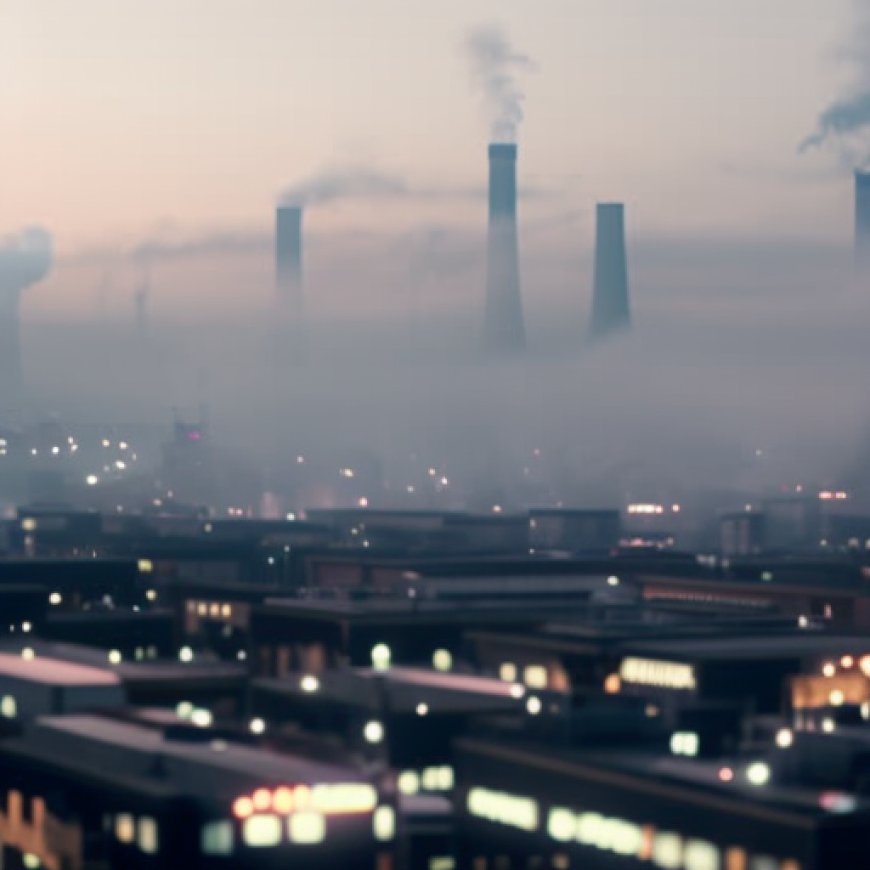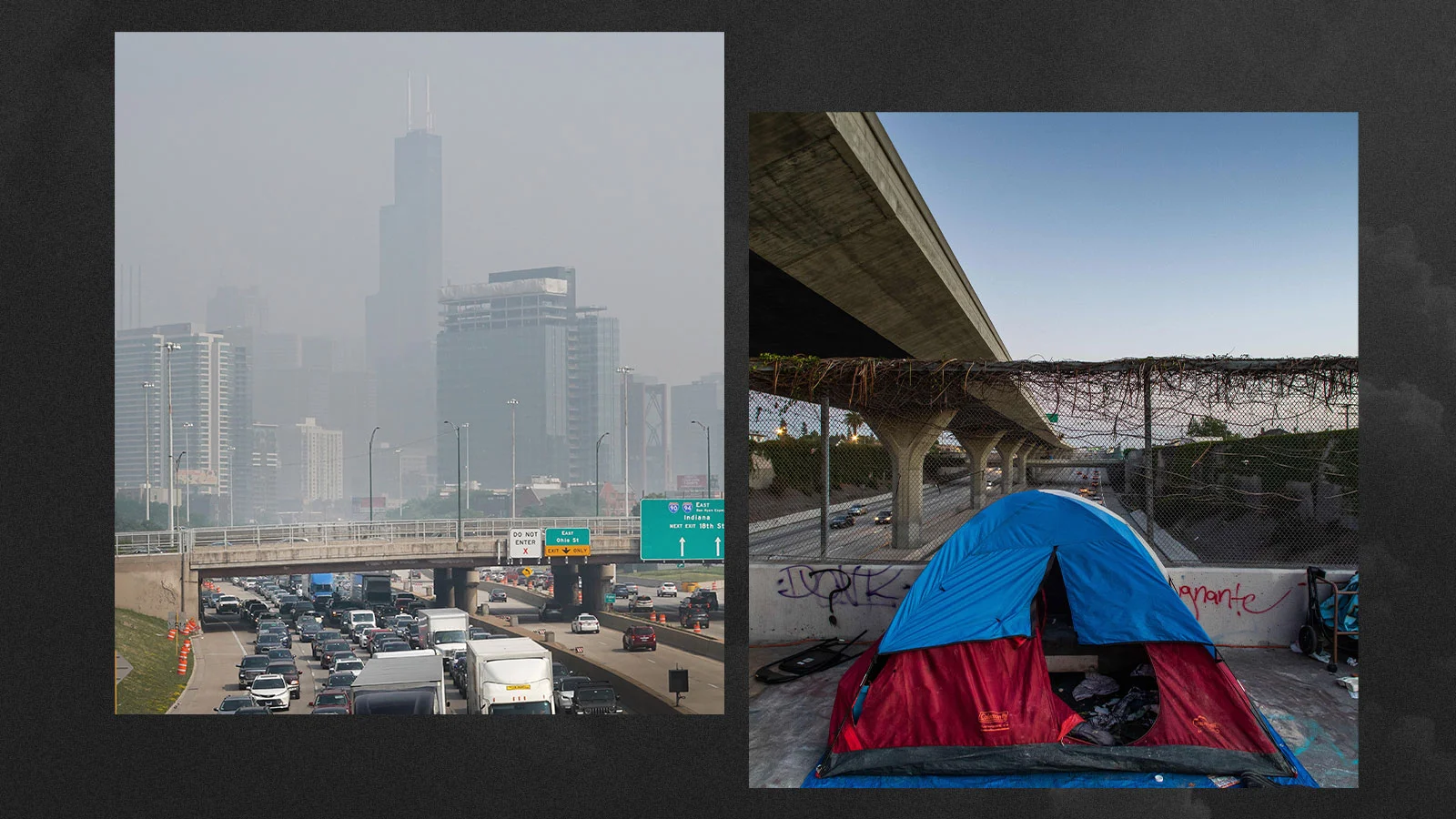How air pollution and the housing crisis are connected – KTVZ
How air pollution and the housing crisis are connected KTVZ


How air pollution and the housing crisis are connected

Getty Images via Grist
Introduction
Two photos side by side, one of smoke and haze over a highway and cityscape, and the other of a tent under a highway overpass.
Air Pollution and Homelessness
As wildfire smoke from Canada plagued parts of the United States for the second time this summer, expanding into parts of the Midwest and East Coast, cities were caught unprepared. While a few put out alerts, outreach was limited.
People walked through the smoke, often with little understanding of the health risks. Once the risks were clear, some people donned masks to prevent lung damage. But when the smoke — and the clear presence of danger — receded, they left the masks behind.
That’s easy enough for people who have a place to call home. But for people who are homeless, either living in a shelter or on the sidewalk, they often have to navigate confusing rules and regulations to receive the type of help they need.
Additionally, for unhoused people, dangerous air isn’t just a threat during an air quality crisis — it’s an everyday occurrence, Grist reporting reveals. People who are unsheltered are the most at risk, living under highway overpasses or closer to industrial areas, which means their exposure to air pollution is 24/7 and not just for a few days.
Case Study: Chicago
In Chicago, unhoused people living in a green space adjacent to a highway overpass were taken aback by the smoke from Canadian wildfires. One resident is worried about how the once-novel event might be the latest in a terrifying “new normal.”
“It was normal on the West Coast and now they have Canadian wildfires up here, now the Midwest is going to be, like, normalized with wildfire [smoke],” said Jared Wilson, 23.
Wilson lives with asthma and has used an inhaler since he was a child. He describes Chicago’s air as being consistently polluted, even before the wildfire smoke rolled in. A recent Guardian analysis placed the city third overall for worst air quality in the U.S. mostly due to truck and car traffic on the city’s South and West sides.
For Joe Muro, 44, a recent transplant also living close to the highway overpass, wildfires are nothing new. He did not expect the smoke to follow from Colorado, where he lived through the destructive Marshall Fire in the winter of 2021.
According to Muro, volunteers came by to offer masks and water to folks living in tents in the area. But he does not recall the good samaritans as being affiliated with a city agency or partner.
The Impact of Climate Change
Everything about the air quality crisis was exacerbated by climate change, from the fires themselves to the weather pattern that blew the smoke directly down the East Coast, according to Kristie Ebi, a professor of global health at the University of Washington.
Though the smoke has cleared again, the U.S. could see another repeat of it, as long as the fires continue to burn — and unhoused people will be the ones most affected, according to advocates.
“With any natural disaster, we emphasize that people experiencing homelessness experience it first, they experience it worst, and they generally experience it longest,” said Katie League, a behavioral health manager at the National Healthcare for the Homeless Council. “Particularly those who are living outside all the time, they don’t have dependable resources.”
Health Risks and Disparities
Highway overpasses or places adjacent to industrial areas can be safe havens for people experiencing homelessness, since they might provide freedom from displacement or harassment from police or other residents.
But those places expose vulnerable people to dangerous air pollutants, and they have few provisions to help them address health issues that might arise. A 2022 study from the Cleveland Clinic found that in Visalia, California, more than 60 percent of unhoused people surveyed often spent time adjacent to roadways –– where their exposure to particulate matter and other air pollutants was constant. Researchers noted that existing equipment probably could not capture the full extent of the pollution people are exposed to when they reside next to a roadway.
One of the main pollutants found in both wildfire smoke and car pollution is called fine particulate matter. PM 2.5, another name for fine particulate matter, is smaller in size than most other types of air pollution, which means that it can
SDGs, Targets, and Indicators
1. Which SDGs are addressed or connected to the issues highlighted in the article?
- SDG 3: Good Health and Well-being
- SDG 11: Sustainable Cities and Communities
- SDG 13: Climate Action
- SDG 17: Partnerships for the Goals
2. What specific targets under those SDGs can be identified based on the article’s content?
- SDG 3.9: By 2030, substantially reduce the number of deaths and illnesses from hazardous chemicals and air, water, and soil pollution and contamination.
- SDG 11.1: By 2030, ensure access for all to adequate, safe, and affordable housing and basic services and upgrade slums.
- SDG 11.6: By 2030, reduce the adverse per capita environmental impact of cities, including by paying special attention to air quality and municipal and other waste management.
- SDG 13.1: Strengthen resilience and adaptive capacity to climate-related hazards and natural disasters in all countries.
3. Are there any indicators mentioned or implied in the article that can be used to measure progress towards the identified targets?
- Indicator for SDG 3.9: Number of deaths and illnesses attributed to air pollution.
- Indicator for SDG 11.1: Proportion of urban population living in slums, informal settlements, or inadequate housing.
- Indicator for SDG 11.6: Ambient air pollution levels in cities (e.g., PM2.5 concentration).
- Indicator for SDG 13.1: Number of people affected by climate-related hazards and disasters.
Table: SDGs, Targets, and Indicators
| SDGs | Targets | Indicators |
|---|---|---|
| SDG 3: Good Health and Well-being | Target 3.9: By 2030, substantially reduce the number of deaths and illnesses from hazardous chemicals and air, water, and soil pollution and contamination. | Indicator: Number of deaths and illnesses attributed to air pollution. |
| SDG 11: Sustainable Cities and Communities | Target 11.1: By 2030, ensure access for all to adequate, safe, and affordable housing and basic services and upgrade slums. | Indicator: Proportion of urban population living in slums, informal settlements, or inadequate housing. |
| SDG 11: Sustainable Cities and Communities | Target 11.6: By 2030, reduce the adverse per capita environmental impact of cities, including by paying special attention to air quality and municipal and other waste management. | Indicator: Ambient air pollution levels in cities (e.g., PM2.5 concentration). |
| SDG 13: Climate Action | Target 13.1: Strengthen resilience and adaptive capacity to climate-related hazards and natural disasters in all countries. | Indicator: Number of people affected by climate-related hazards and disasters. |
Based on the article, the issues discussed are connected to multiple SDGs. SDG 3 (Good Health and Well-being) is relevant because it addresses the impact of air pollution on people’s health, particularly those who are homeless. SDG 11 (Sustainable Cities and Communities) is connected to the housing crisis and the need for adequate, safe, and affordable housing for all. SDG 13 (Climate Action) is relevant due to the link between air pollution, wildfires, and climate change. Lastly, SDG 17 (Partnerships for the Goals) is indirectly addressed as the article highlights the need for coordinated responses and partnerships to address these issues.
The specific targets identified based on the article’s content include reducing deaths and illnesses from air pollution (SDG 3.9), ensuring access to adequate housing and upgrading slums (SDG 11.1), reducing adverse environmental impacts of cities, including air quality (SDG 11.6), and strengthening resilience to climate-related hazards (SDG 13.1).
The article mentions or implies several indicators that can be used to measure progress towards these targets. These indicators include the number of deaths and illnesses attributed to air pollution (SDG 3.9), the proportion of urban population living in slums or inadequate housing (SDG 11.1), ambient air pollution levels in cities (SDG 11.6), and the number of people affected by climate-related hazards and disasters (SDG 13.1).
Behold! This splendid article springs forth from the wellspring of knowledge, shaped by a wondrous proprietary AI technology that delved into a vast ocean of data, illuminating the path towards the Sustainable Development Goals. Remember that all rights are reserved by SDG Investors LLC, empowering us to champion progress together.
Source: ktvz.com

Join us, as fellow seekers of change, on a transformative journey at https://sdgtalks.ai/welcome, where you can become a member and actively contribute to shaping a brighter future.







